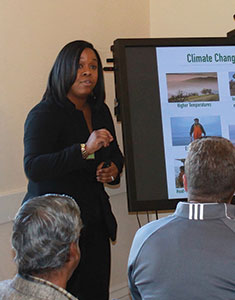Kathy Sutphin
As assistant dean for academic affairs in the College of Natural and Mathematical Sciences, Kathy Sutphin ’95, political science, has had a key role in creating, implementing and/or supporting a number of projects to assess and advance student outcomes, including new teaching spaces such as the CASTLE and the Science Learning Collaboratory. She has also been active in programs that support transfer student success (the CCCSTEP, and the STEM Transfer Student Success Initiative) and help provide pathways for students into research careers (the MARC U*STAR Program at UMBC). Sutphin’s most recent collaborative project – the STEM BUILD at UMBC Initiative – was recently funded by a $18 million grant from the National Science Foundation.
What follows are edited excerpts from a recent UMBC Magazine interview with Sutphin
Read our full story about how staff built UMBC’s infrastructure for student success.
On how UMBC works:
“It used to be UMBC had gotten as far as it had because the faculty and staff were very talented, and lots of times they could use their talents in roles and they would excel. But there were many small shops that were often dependent on one person. And now everything has grown and evolved, so you don’t just have one person. You have groups of talented people, and then they work together to make a difference.”
On what issues in student success motivate her:
I’m particularly interested in transfer success. And so one of the first projects I worked on in the college was writing a proposal targeting transfer students’ success. And it didn’t get funded, so I worked with [Dean] Geoff Summers. I said, “Well, how about we just try and pilot it, so we can understand some of the challenges that are going on with transfer students?” Because I was a transfer student, and I really understood that it’s a different world coming from there, and it’s not a question of talent, it’s just a question of knowing the right pathway, and how to be successful, and study a little differently. Because UMBC is an intense university; it’s rigorous.
So we tried a little experiment and we called it CCCSTEP, and we worked directly with the transfer students, and we really asked a lot of questions. And we learned a lot. At UMBC, “I think we identify an area that we want to explore, and then we expand it.” For example, the Chemistry Discovery Center paved the way for the CASTLE, which was fun to put together with Provost Philip Rous. And then [William LaCourse, dean of CNMS, had the idea of doing the Science Learning Collaboratory, and now these projects have evolved into the Interdisciplinary Life Sciences Building. “We learn and grow, and keep trying to do a better job.”
On what’s special about UMBC:
When I travel, I talk with people from other universities, I think what’s kind of unique about UMBC is that people stay. And I think you can get a lot done when you keep the same people. They may be in different jobs; they move around, but they stay at UMBC. Which I think is a cool thing.
Tags: Winter 2016



